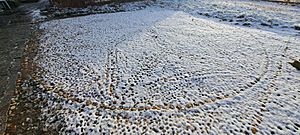John Weaver (dancer) facts for kids
John Weaver (born 1673 – died 1760) is known as the father of English ballet. He also helped create English pantomime. He was a dancer, a dance teacher, and a choreographer. He created many dance shows.
Contents
John Weaver's Early Life and Dance Journey
John Weaver was born in Shrewsbury, England. He was baptized on July 21, 1673. His father, also named John Weaver, was a dance teacher. Young John went to the local Free School.
His father thought he should go to London. He wanted John to become a ballet master. Weaver left Shrewsbury around 1696 or 1697. His first known performance in London was in the summer of 1700. Weaver became very good at funny dance roles. He created a comedy show called Tavern Bilkers in 1702.
Spreading New Dance Ideas
In the early 1700s, Weaver joined other dance teachers. They wanted to share a new French way of writing down dances. This was called dance notation. Weaver translated a French book called Choregraphie into English. He named his translation Orchesography (1706). This made the dance instructions available to more people.
He also wrote down six court dances by Mr. Isaac. Mr. Isaac was Queen Anne’s dance teacher. In 1707, Weaver added a dance called The Union. This dance celebrated the Queen's birthday. It also honored the joining of England and Scotland. Weaver met the dancer Hester Santlow around this time. She performed The Union for the Queen. Weaver then moved back to Shrewsbury in late 1707 or early 1708.
Writing About Dance History
In Shrewsbury, Weaver started writing his own book. It was called An Essay towards an History of Dancing. It came out in London in 1712. In this book, he wrote about ancient dancers. He admired the mimes and pantomimes of old times. He also looked at the stage dancing of his own day. Weaver shared his ideas on how to make dance better. He wanted dance to be seen as a serious art form. He hoped it could be as important as plays. He achieved this goal when he returned to London in 1717. There, he created The Loves of Mars and Venus.
The Loves of Mars and Venus: A New Kind of Ballet
The Loves of Mars and Venus was a very important show. It was first performed at Drury Lane theatre on March 2, 1717. This show told a story from old myths. The dancers used many gestures. They did not speak any words.
Weaver used the story and feelings to tell the tale. He did not use fancy dance moves or speech. Because of this, he greatly influenced later choreographers. These included Jean-Georges Noverre and Gasparo Angiolini.
Other Writings and Stage Shows
Weaver wrote other important books about dance. He published A Small Treatise of Time and Cadence in Dancing in 1706. This was another translation of a French dance book. In 1721, he published "Anatomical and mechanical lectures upon dancing." This book explained rules for dancing.
In 1728, he updated parts of his 1712 book. He made it easier for everyone to read. He called it The History of the Mimes and Pantomimes. Weaver also wrote for The Spectator magazine. His friend Richard Steele edited the magazine. Steele called Weaver a "Philosopher" of dance.
Weaver also produced other plays with dance. These included The Shipwreck; or Perseus and Andromeda (1717). This was a funny dance show. He also created Orpheus and Eurydice (1718). This was a "Dramatick Entertainment in Dancing." His last major show was The Judgment of Paris (1733). This combined dancing and singing.
John Weaver's Personal Life
John Weaver was married two times. His first wife was Catherine. She passed away in 1712. They had two sons and one daughter. His second wife was Susannah. She lived longer than him. Susannah died in 1773 when she was 73 years old.
Later Life and Legacy
Weaver's later shows were not as successful. By 1721, he focused more on the science of dance. He wanted to make dance a respected art form. In 1720, he moved his family back to Shrewsbury. But he returned to Drury Lane in 1728–29. He worked there as a producer and dancer.
After 1733, he left the stage for good. He went back to Shrewsbury. There, he ran his boarding school. He is thought to have taught dancing almost until he died. John Weaver passed away on September 24, 1760. He was 87 years old. He was buried in Shrewsbury.
Celebrating John Weaver's Impact
A special event called the John Weaver Dance Festival was held. It took place from March 17-19, 2023. This festival celebrated 350 years since his birth. It included a dance showcase, talks, and an exhibition. Many events were held at Shrewsbury School. Items from the Soulton Hall collection were shown. These items were about dance and an old dancing pavement.
See also
- List of dancers



